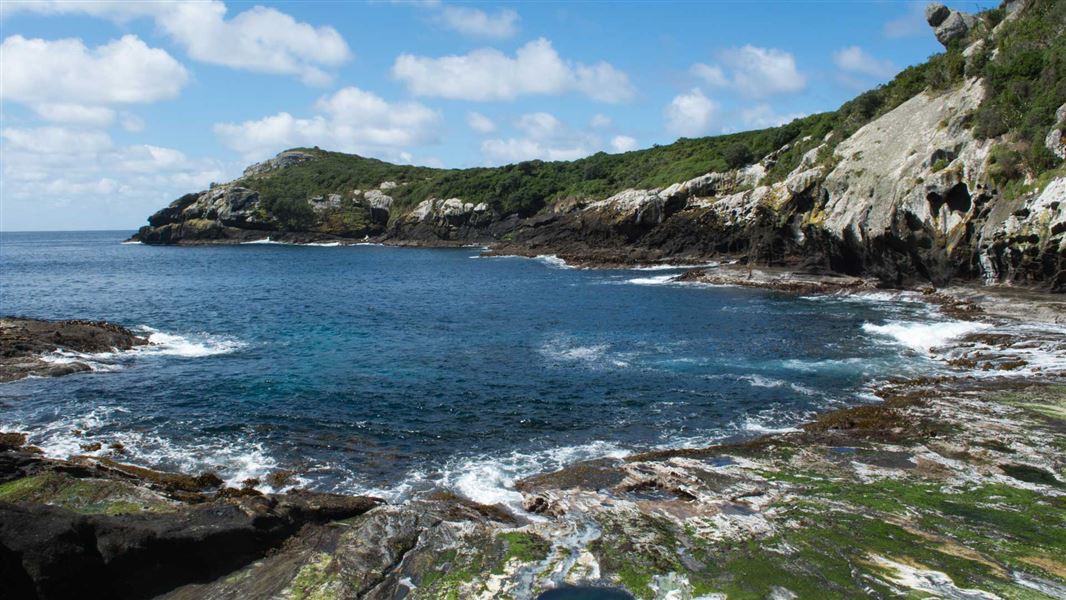Habitats
The diversity of habitats on the Chatham Islands is surprising. Chatham Island, the largest of the islands has a high southern tableland flanked by towering cliffs and a gentle northern portion encompassing extensive waterways, low peatlands and sweeping sand beach systems. The other main island, Pitt, has a heartland of forest and treelands and a coast of wild cliffs, headlands and sand beaches. Around the main islands are two smaller islands (Mangere and Rangatira), several clusters of islets and rock stacks.
The geology of the archipelago is complex, consisting of ancient volcanics and schists and more recent sediments, including limestone. The land has been uplifted, eroded and drowned several times. This has resulted in a mosaic of habitats: steep, gentle, wet, dry, acidic, lime-rich, exposed and sheltered. The richness and distinctiveness of the flora and fauna reflect that.
The long isolation of the Chathams is reflected in the absence of beeches or podocarps (conifers), kamahi, manuka, kanuka or rata, so ubiquitous on mainland New Zealand. There are also no bats, frogs, geckos, sandflies, moa or kiwi.
The oceanic situation of the Chathams also has a profound influence on the nature of habitats. The islands are continually swept by moist salt-laden winds and have a generally moderate climate with few temperature extremes and modest sunshine hours. Prior to human arrival, millions of sea birds would have burrowed, trampled and enriched the soil on every part of the land. Masses of seals would have been based on the coasts. The forests and wetlands would have been vibrant with birds and invertebrates. Under these circumstances the endemic megaherbs developed, tree daisies grew to immense size and many species of endemic birds and insects arose and flourished.
People have lived in the Chathams for many hundreds of years. The legacy of that occupation is a decimated bird, invertebrate and marine mammal fauna, a very fragmented vegetation cover and a somewhat depleted flora. Fire, tree felling, pigs, domestic stock (frequently gone feral), possums and rodents have made major impacts, some of which are irreversible. Many plants have been introduced, both from mainland New Zealand and from other countries. However, examples of most of the indigenous communities and ecosystems have survived, and the natural character of the Chatham Islands is still apparent almost everywhere.
Chatham Island habitats and protected areas factsheet (PDF, 682K)
Protected areas
Much of the natural character of the Chatham Islands is protected in a network of areas set aside for conservation. These fall into the following groupings:
Island refuges
Mangere and Rangatira (South East Island) are nature reserves managed by DOC. Now free of introduced predators and herbivorous mammals, they are the last refuges for some species. They are managed to protect threatened endemic fauna and flora and to restore the indigenous habitats for those animals and plants. Visits are generally for management purposes and by permit only. The main threats are fire and the potential arrival of cats, rodents, possums and weeds.
Crown reserves and conservation areas
On Chatham and Pitt there is a network of protected areas managed by DOC. These include:
- 1 nature reserve (Tuku)
- 7 scenic reserves (Canon-Peirce, Harold Peirce, Manauea/Ocean Mail, Henga, Te Awatea, Rangaika and Pitt Island)
- 1 national historic reserve (Hāpūpū/J.M. Barker)
- 2 historic reserves (Kairae and Taia)
- 4conservation areas (Chudleigh, Tangepu, Green Swamp and Nikau Bush).
The focus of management is to protect and restore natural ecosystems, indigenous fauna and flora and cultural heritage features. Public walking tracks and interpretation panels are maintained in Henga, Hāpūpū/J.M. Barker and Nikau Bush reserves. A permit is required to enter Tuku Nature Reserve.
People may visit other areas so long as they first obtain permission to cross private land en route and abide by the Environmental Care Code.
Private protected land
Many areas of privately-owned land are protected for conservation on both of the main islands. The number has been steadily growing in the last few years until they now outnumber crown-owned protected areas. Most are legally covenanted in perpetuity and have management agreements DOC. The Nature Heritage Fund has provided funding for fencing, survey and legal costs for most of these areas.
Several other areas are legally protected for 25 years under the Nga Whenua Rahui programme. The QE II National Trust also provides opportunities for legal protection of private land (Open Space Covenants in perpetuity). Whatever mechanism is used, ownership is retained by the landowners and public access is by their permission.
Planting, stock exclusion, weed control and animal-pest control are all part of their management, usually in partnership with DOC. These areas are conserved through the generosity of the landowners. They complement the crown-owned network of reserves and make a major contribution to the protection and restoration of indigenous habitats and historic features of the Chatham Islands.
